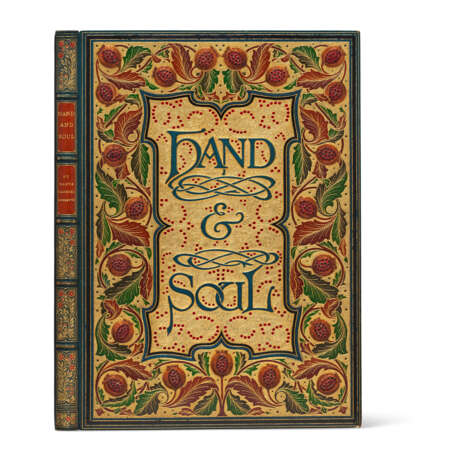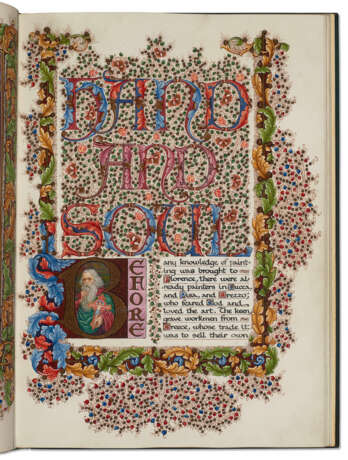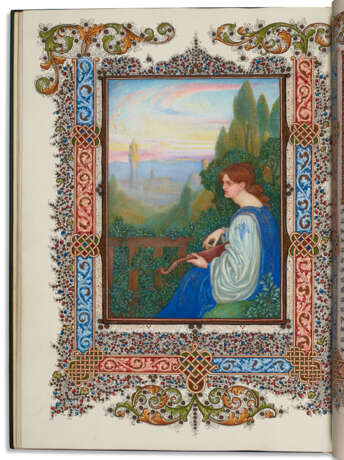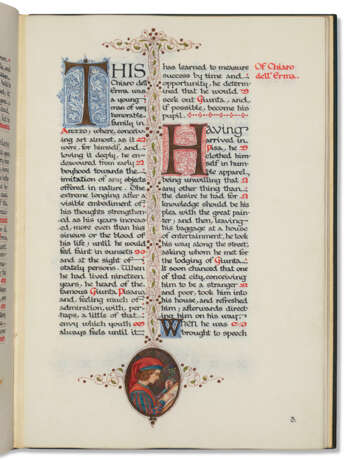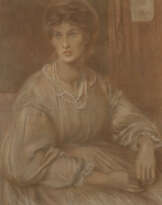ID 820101
Los 586 | Sangorski & Sutcliffe, binders and illuminators
Schätzwert
$ 30 000 – 50 000
ROSSETTI, Dante Gabriel (1828-1882). Hand and Soul. Commissioned by Gannon and Cassidy of New York, London, c. 1908.
A beautiful manuscript of Rossetti’s influential short story, appropriately illuminated in early Italian Renaissance style and in a binding embellished with carved pomegranates and over 450 jewels. Created about 50 years after Rossetti wrote the story, this spectacular Sangorski and Sutcliffe manuscript and binding pays full tribute to his ideals. The relievo pomegranates on the front cover are an unusual and appropriate addition and feature 18 garnets each.
Folio (304 x 215mm). Illuminated manuscript on vellum, 18 leaves, plus three blank vellum leaves at front and two at back plus manuscript colophon leaf on vellum, mounted on guards. Richly illuminated on almost every page including two full-page miniatures with illuminated borders in pre-Raphaelite style, and initials of stippled gilt on alternating blue and red penwork; ten border or initial illuminations featuring portraits and landscapes.
Full crushed blue-green morocco by Sangorski & Sutcliffe, morocco doublures, all edges gilt. The upper cover with sunken panel enclosing the title “Hand & Soul” with two flourishes in relief, all on a richly gilt gold ground in a leaf and berry pattern; panel surrounded by a pattern of pomegranates and pomegranate leaves, the 21 pomegranates individually carved in relief and set with 18 garnets each. The lower cover with an elaborate strapwork design with heart-shaped corner-pieces enclosing a central sunken panel on fine gilt pointillé, the edges decorated with 20 flowers of gold and jewels, set with four topazes each. Inner doublures with a grapevine and strapwork design; the upper doublure with the author’s monogram; the lower doublure with the author’s motto; green morocco flyleaves, silk endleaves.
“Art should be created from the soul, for the soul.”
A beautiful manuscript of Rossetti’s influential short story, appropriately illuminated in early Italian Renaissance style and in a binding embellished with carved pomegranates and over 450 jewels. Hand & Soul was first published in 1850 in the pre-Raphaelite periodical, The Germ. It tells the story of a fictional 13th century Italian painter and his quest for artistic expression. Created about 50 years after Rossetti wrote the story, this spectacular Sangorski and Sutcliffe manuscript and binding pays full tribute to Rossetti’s ideals. The carved pomegranates on the front cover are an unusual and appropriate addition and feature 18 garnets each.
Folio (304 x 215mm). Illuminated manuscript on vellum, 18 leaves, plus three blank vellum leaves at front and two at back plus manuscript colophon leaf on vellum, mounted on guards. Title in gilt, epigraph in gilt and red, two-page illuminated preface, calligraphed text of the poem on pages 1-27 in red and black inks; richly illuminated on almost every page including two full-page miniatures richly painted with illuminated borders of acanthus leaves, gold sprays, interlocking designs, all in pre-Raphaelite style, initials of stippled gilt on alternating blue and red penwork grounds, other initials with variously colored acanthus leaves and elaborate border extensions; ten border or initial illuminations featuring portraits and landscapes; all richly illuminated in colors, gold, tooled gold, and ink (scattered few rubs, touch of soiling to half-title). Calligraphed certification leaf at end: “This … was written-out, illuminated and bound by F. Sangorski and G. Sutcliffe of London for Gannon & Cassidy of New York. Registered design no. 593025.”
Full crushed blue-green morocco by Sangorski & Sutcliffe, morocco doublures, all edges gilt. The upper cover with sunken panel enclosing the title “Hand & Soul” with two flourishes in relief, all on a richly gilt gold ground in a leaf pattern with red morocco berries, the inside of the panel bordered in black morocco and a gilt rule; panel surrounded by a pattern of pomegranates and pomegranate leaves executed on a fine gilt pointillé background with leaves in two shades of green morocco and two shades of brown morocco gilt, the 21 pomegranates individually carved in relief and set with 18 garnets each, black morocco border gilt ruled. The lower cover with an elaborate strapwork design executed in red, mauve, black, green, and brown moroccos, with heart-shaped corner-pieces and dividing the cover into four quadrants each with diapered ground of green and brown morocco gilt with red and green morocco dots; border on fine gilt pointillé with small white and pink morocco flowers; all enclosing a central sunken panel on fine gilt pointillé in a leaf pattern and decorated with olive and dark brown strapwork, the edges decorated with 20 flowers of gold and jewels, set with four topazes each. Spine gilt in six compartments with raised and gilt bands, two with brown morocco lettering pieces, the others finely gilt and inlaid with red morocco flowers; board edges with gilt rule (slight rubbing to corners). Inner doublures are nearly identical with a central circular panel on fine gilt pointillé with a grapevine design executed in purple, green and brown morocco, bordered with cream and green morocco gilt, surrounded by a floral diapered design in white, green and purple morocco; all with strapwork border in various colors and gilt, red morocco dots; the upper doublure with the author’s monogram at center; the lower doublure with the author’s motto; stamp-signed by the binders on upper doublure. The upper and lower green morocco flyleaves have mauve and black morocco borders and decorative gilt cornerpieces, green silk endleaves (light wear to silk, bookplate removed from silk). Full morocco box lined with silk and velvet (box stained and broken).
Provenance
Phoebe A.D. Boyle; Anderson Galleries, 20 November 1923, lot 263.
Acquired by Gabriel Wells.
Sotheby's New York, 11 December 1984, lot 104.
The Book as Art, Part I, Sotheby’s New York, 2 June 1995, lot 352.
Acquired by Ann and Gordon Getty from the above.
| Künstler: | Dante Gabriel Rossetti (1828 - 1882) |
|---|---|
| Herkunftsort: | Nordeuropa, Europa, Vereinigtes Königreich |
| Kategorie des Auktionshauses: | Briefe, Dokumente und Manuskripte |
| Künstler: | Dante Gabriel Rossetti (1828 - 1882) |
|---|---|
| Herkunftsort: | Nordeuropa, Europa, Vereinigtes Königreich |
| Kategorie des Auktionshauses: | Briefe, Dokumente und Manuskripte |
| Adresse der Versteigerung |
CHRISTIE'S 20 Rockefeller Plaza 10020 New York Vereinigten Staaten | ||||||||||||||
|---|---|---|---|---|---|---|---|---|---|---|---|---|---|---|---|
| Vorschau |
| ||||||||||||||
| Telefon | +1 212 636 2000 | ||||||||||||||
| Fax | +1 212 636 4930 | ||||||||||||||
| Nutzungsbedingungen | Nutzungsbedingungen | ||||||||||||||
| Versand |
Postdienst Kurierdienst Selbstabholung | ||||||||||||||
| Zahlungsarten |
Banküberweisung | ||||||||||||||
| Geschäftszeiten | Geschäftszeiten
|
